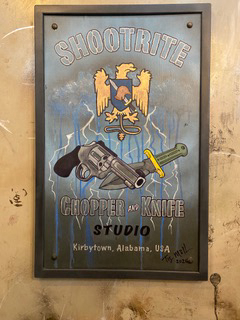This look back is a piece from Publisher Jim Shepherd in which he discusses training with our friend Tiger McKee. It's worth remembering.
For more than a decade, readers of the Wires have gotten the benefit of the training and shooting insight of Tiger McKee. The soft spoken Alabamian says he’s “never been a soldier, bodyguard or a ninja” but that’s only a part of his story. His father was a notable warrior, and Tiger grew up where being able to take care of business was a very high priority.
This week, after a hurricane drowned my planned trip to Gunsite Academy, I was determined to spend some much-needed quality time on a range…somewhere.
In a moment of “head-slap clarity” I realized one of the country’s top trainers -and a better-than-middling knife maker and gunsmith, only lived about 1 percent of the distance from my house to Gunsite Academy.
A couple of calls were made, an RV parking spot located, and suddenly I had plans for what would have otherwise been a lost week. We’re so close, I didn’t have to plan fuel stops or deal with the complications of six days of solo travel in an RV in this time of social distancing.
Tiger’s one of those trainers that never raises his voice, doesn’t ridicule you for an occasional bonehead shot (as long as you don’t violate a safety rule), and makes his point in a considered style that makes you wonder why some instructors feel the need to scream about everything.
He doesn’t shoot your gun to impress you with his abilities (although they’re impressive) or take every opportunity to suggest you’re using the “wrong” gun. He teaches you to shoot what you have - but that doesn’t mean you won’t want to improve your equipment. As you progress, you’ll learn that some gear will turn out to be best for you. His ability to explain points to consider when deciding what gun, holster, sight or light might be “right” for you and simpler.
Like everything else, his goal is to help you improve.
In short, he’s a student of teaching. Having read his Book of Two Guns (Amazon: https://www.amazon.com/Book-Two-Guns-Martial-Carbine/dp/1419601806) more than one time over the past decade, I know he is constantly looking at the art of shooting the same way great teachers look at teaching any skill: how do I best to communicate the information in its most usable, understandable form to every student.
He proved that to me again this week while I was imposing on his range. What was a simple testing session (more on that later) evolved into an impromptu lesson.
Great instructors can’t help but offer help when needed.
Like all the other instruction he’s offered me over the years- either in person or via his writing- it helped.
As I was working with several small handguns, all equipped with red dot sights, I was making initial hits. My accuracy slipped about half-way through each magazine. As he was watching, he said I was anticipating the trigger break. When I had no expectation of when the trigger would break, shots were right on the money. As I got more familiar with the gun, I was unconsciously anticipating trigger break.
The gun was barely moving, but bullet impacts don’t lie. If where you aim is different from where you hit, you’re moving something.
His range fix, having me start to count slowly aloud as I pressed the trigger seemed to work, and rounds moved back to the center of the steel plate.
But as I got over the self-consciousness of counting aloud, rounds started moving again. I was baffled, but as we talked, he realized it was a mental issue, not a physical one.
Rather than pressing the trigger straight back, I was trying to squeeze the trigger. A good trigger press stabilizes the finger. A squeeze induces motion-and motion means misses.
No matter how much instruction you’ve had, not interpreting the material correctly means you’re applying it incorrectly.
My basic grip technique was flawed. He quickly moved us into the shade and showed me the difference between what he was saying and how I was interpreting it.
Turns out I squeezed a trigger the same way I gripped a handgun- and both were wrong.
His suggestion: associate a straight-back motion with my trigger finger, rather than tightening the entire finger (squeeze).

Tiger McKee expanded his offerings to include customized Smith & Wesson revolvers and limited edition knives.
|
Everything stabilized while I dry fired, so we moved to the range. There, the rounds found the center of the plate far more often -and consistently-than before. We tried the “fix” on four different guns I’d brought along to give long-overdue test runs. They were different feeling guns, but the idea of pressing the trigger rather than squeezing it, made them all simpler to shoot accurately. Ultimately, that’s the only goal of shooting - to hit your target.
Tiger had identified a problem that wasn’t due to mechanics or technique. It was an incorrect comprehension of terminology.
Reading Tiger’s insights in the Outdoor, Shooting or Tactical Wires, you imagine his writing to be like his teaching. It is straightforward and designed to inform you in the most understandable manner possible. It takes a whole lot of knowledge to teach anything in an easy to understand style.
If you imagine what it would be like to see that knowledge applied to firearms and knives, you’re going to enjoy the second part of my time with Tiger.
— Jim Shepherd